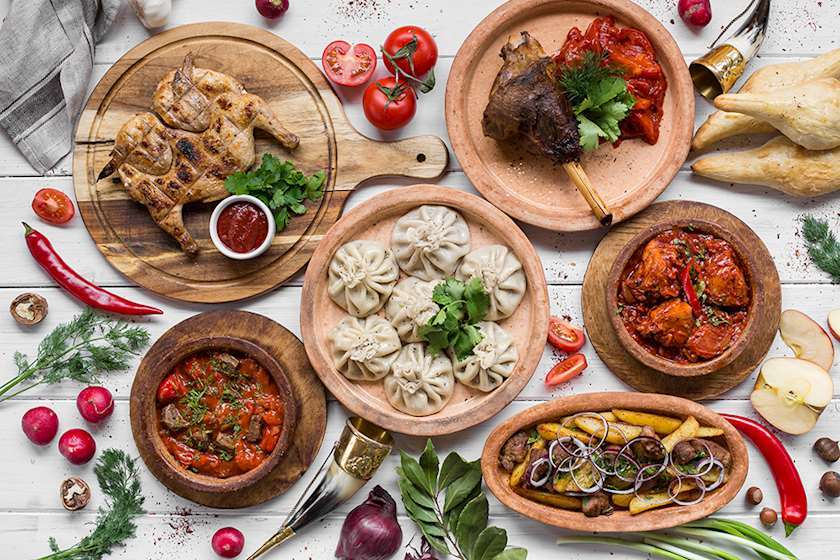The authentic and unique Georgian food is a vibrant, delicious representation of the rich culture and history of this country. Georgian cuisine was a secret for centuries, but now that Georgia attracts millions of tourists each year, it has been revealed and recognized as the culinary masterpieces they are. Georgian food is considered to be as old as Georgia itself by many historians. Georgian cuisine has always been a part of Georgian culture and everyday life. It has evolved and improved over time as neighboring cuisines have been adapted to the Georgian palate.
The Georgian supra or feast is closely linked to the Georgian culinary tradition. The supra is more than food. It’s a culture of social communication that takes place around a single table. The essential elements of a supra are a tamada, wine and traditional food. The supra is a popular way of sharing emotions and thoughts with others. Since the supra is a tradition that has been observed for centuries, it’s been common to cook traditional dishes in every family. This ensures that ancient recipes are well preserved.
Georgian cuisine has a wide variety, and each region is famous for its own signature dish. Moreover, the same dish is cooked differently in different regions. Georgian cuisine can be divided into two distinct cuisines: the eastern and western cuisines. The eastern cuisine is characterized mainly by meat dishes, such as pork, beef, and mutton, white bread, and animal fat. Westerners, on the other hand, use more chicken, corn flour and nuts, vegetables, and sauces. This wide variety of dishes allows for all dietary requirements to be met.
Georgian recipes embody the phrase “Everything clever is simple”. Georgians are known to have been involved in both agriculture and livestock since ancient times. They also harmoniously combine products from these two industries into their cuisine. One of the most popular Georgian dishes, for example, is the traditional bread filled with cheese known as Khachapuri. Georgian cuisine would be incomplete without this rich dish, which uses white flour (a product from wheat and agriculture) and cheeses (a product from cow’s dairy and animal husbandry).
Georgian dishes with pork are plentiful. Grilling meat on a skewer, or mtsvadi in Georgian, is one of many ways to enjoy the flavor of pork. Local kebabs, or Mtsvadi, are usually made from veal or pork. Mtsvadi, or local kebabs, are usually made of pork or veal.
Georgians grill mutton less often than other countries of the region. Georgian cuisine, however, offers a mouthwatering chaqapuli which is a mutton dish with fresh cherry-plums and tarragon. It comes from the Kakheti area of Georgia.
Kakheti is the birthplace of Georgian winemaking. Nowhere else in Georgia does so much wine production take place. Kakheti is the wine-making capital of Georgia. Georgia has more than 500 different types of wine and it would be impossible to imagine local cuisine without wine. Wine enhances each flavor and adds a new dimension to it. True gourmets will find wine to suit almost any dish.
The Georgian meat dumpling (khinkali) is one of the rare dishes that Georgians eat without wine. It was originally made in the mountains of the northern part of Georgia. Khinkali are different from other meat-dumplings in the world because of their round and wrinkled shape, which represents the sun. In the Georgian culture of highlanders who were pagan, the sun was a very important symbol. Khinkali can be filled with lamb, pork, beef or cheeses. Locals drink beer, homemade jipitauri vodka or homemade jipitauri with khinkali. They always eat them with their hands.
Try the Georgian Satsivi for a cold, refreshing dish. The word “tsivi”, from which this dish gets its name, is translated as “cold”. Satsivi is made of a thick sauce with walnuts, spices and fried chicken or turkey. Many culinary experts believe that satsivi, the Georgian dish, is the most complex. This may explain why it is traditionally served at Christmas and other holidays.
Georgians don’t just use walnuts and local spices to create Satsivi. pkhali is a popular Georgian appetizer. It is a mixture of walnuts, spices and cooked eggplant. Badrijani is Georgian cuisine at its best. It consists of a walnut paste that’s stuffed inside fried eggplant.
Georgian food would not be complete without mentioning local sweets and snacks. The most common ingredient in Georgian food is nuts. This includes traditional sweets and snacks. Georgians love churchkhela. It is made by beading almonds on a string and dipping them in grape juice thickened with flour. The mixture takes on a ‘candle-like’ shape after it has dried. The tasty churchkhela, which is high in calories and can be stored and transported for a long period of time, was originally invented to feed soldiers on military expeditions.
To end this introduction to Georgian cuisine, we should mention gozinaki. This traditional Georgian dessert is made from honey and walnuts, and it’s served during the New Year. After eating the New Year’s feast, it is customary to drink a glass of wine.

